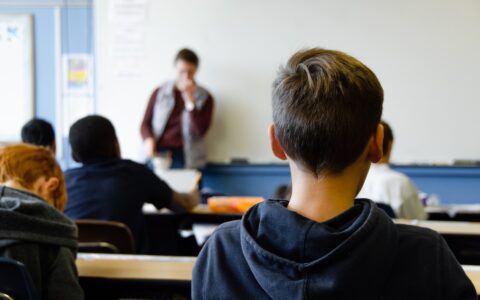Taking Active Steps Toward Bullying Prevention
Sarah Gibson
Whether in person or online, our society has become increasingly intertwined. Even though we now have more ways to connect with people through social media, texts, calls, or video chats, these same means of connection can also cause us to feel distant from one another.
 One area where this is keenly seen is with regard to bullying. Bullying is one such way in which people ignore the basic needs, dignity, and humanity of others. Bullying affects both adults and children, leading to feelings of isolation, anxiety, low self-esteem, and even depression.
One area where this is keenly seen is with regard to bullying. Bullying is one such way in which people ignore the basic needs, dignity, and humanity of others. Bullying affects both adults and children, leading to feelings of isolation, anxiety, low self-esteem, and even depression.When it comes to children, bullying most often happens at school, but it also can take place online as well. Those who are more at risk of being bullied are:
- People who are considered weak or unable to defend themselves
- Those who identify as lesbian, gay, bisexual, transgender, questioning, intersex, and two-spirit
- People who are perceived as being different based on their weight, what they wear, or their social status
- Those who have a physical, mental, or intellectual disability
Bullying Prevention by Understanding Bullying
To develop effective strategies to prevent bullying, we must understand the nature of bullying. According to the National Association of School Psychologists (NASP), bullying is characterized by the following:
Intentional It is unwanted, aggressive behavior that is intended to cause emotional or physical harm.
Repeated Unwanted behavior is repeated multiple times or has the likelihood of being repeated many times.
Power imbalance Bullying involves an imbalance of power between the target and perpetrator(s) based on a person’s weight, real or perceived race, color, national origin, religion or religious practices, disability ethnic group, sexual orientation, gender, physical appearance, sex, or other distinguishing characteristics. In other words, when two kids with no perceived or real power imbalance have an argument, fight, or disagree with one another that is not bullying.
Bullying can find expression in various ways, and there are at least three types of bullying:
 Physical bullying involves hurting a person’s body or threatening their belongings. Physical bullying is a more direct form of bullying that can include spitting at or on them, hitting the other person, tripping them up or shoving them, taking, or breaking their stuff, or making crude or insulting hands and other gestures.
Physical bullying involves hurting a person’s body or threatening their belongings. Physical bullying is a more direct form of bullying that can include spitting at or on them, hitting the other person, tripping them up or shoving them, taking, or breaking their stuff, or making crude or insulting hands and other gestures.
Verbal bullying refers to saying or writing callous things. It includes name-calling, taunting, making threats, teasing, or making inappropriate sexual comments.
Social bullying, which at times is referred to as relational bullying. This type of bullying involves undermining someone’s reputation or relationships, and it includes deliberately leaving someone out or telling others to exclude them, spreading rumors about them in person or online, and embarrassing, shaming, or humiliating them publicly. When social bullying takes place online, it is a form of cyberbullying.
The Impact of Bullying
Bullying behaviors typically co-occur, and whether the bullying a child experiences is direct (meaning it includes but isn’t limited to verbal abuse or physical aggression), indirect, or takes place in cyberspace through electronic media, bullying can have an enormous and lasting impact on children, including the victims, perpetrators, and bystanders.
Some of the impact of bullying on the kids who get bullied includes the damage to their social lives. Relationships are affected by bullying, and children can experience marginalization and social withdrawal due to being bullied.
Another facet is the psychological impact, where there is often an increased prevalence of internalizing behaviors such as depression and anxiety in those children who are bullied. A child who gets bullied may experience increased feelings of sadness and loneliness.
Additionally, bullying impacts a child’s academic life and performance. Bullying can lead to decreased academic performance either due to absenteeism or school avoidance or because of the effect of psychological and/or physiological symptoms. Kids who are bullied are more likely to miss, skip, or drop out of school altogether.
 Lastly, bullying has a physiological impact due to increased levels of stress, feelings of distress, changes in their sleep and eating patterns, and a loss of interest in activities they used to enjoy. These issues may persist into adulthood.
Lastly, bullying has a physiological impact due to increased levels of stress, feelings of distress, changes in their sleep and eating patterns, and a loss of interest in activities they used to enjoy. These issues may persist into adulthood.
The kids who bully others can also engage in violent and other risky behaviors into adulthood, and those who are bystanders and witness bullying are more likely to have increased mental health problems, including depression and anxiety, and they may miss or skip school as well.
No one is left unscathed by bullying, so it’s for everyone’s benefit to minimize or eliminate bullying behaviors.
Bullying Prevention
To come to grips with bullying, a variety of strategies must be employed, and it takes the sustained efforts of all to get things done.
Help kids understand bullying. First, our children must understand what bullying is, and why it is harmful. Sometimes a child will engage in bullying behaviors without understanding the impact or implications of their actions. Educating them may make all the difference in the world.
Those who are being bullied may have internalized and normalized that behavior when they shouldn’t have, and they too need to be encouraged and taught that it’s not okay, and they may need help in identifying bullying behaviors. If you are a parent or a caregiver, you should also familiarize yourself with the anti-bullying policies and rules at your child’s school.
Keep the lines of communication open. Our kids need to know that they can come to us with any issue, and they will be received warmly and with empathy. The isolation a child can feel because of bullying needs to be countered with the empathetic presence of their parent(s) or caregiver, and we need to allow them room to express their concerns.
Speak with your child often about this and help them to understand what they can do if they or someone they know is being bullied. You can reach out to your child’s school for help if your child is being bullied, or if you know of a child who engages in bullying.
Schools can help with preventing bullying by:
- Collaborating with child psychologists and other specialists to create anti-bullying policies. These must then be communicated to staff, parents, and students. The teaching staff can also receive training in how to help the children under their care, whether it’s those who are being bullied, the bullies, or bystanders.
- Integrating bullying prevention material into the curriculum
- Encouraging their students to stand up to bullies, report incidents, and support the victims of bullying
Bullying Prevention Closer to Home: Counseling in Richardson
One way to think about bullying prevention is to look a bit closer to home. Bullying can affect every family and often the bullying behaviors mentioned earlier start at home. Perhaps you or your child may engage in bullying behaviors without being aware of it or characterizing it as such. It may be that what you consider assertiveness or “just kids roughhousing” is bullying and could be negatively affecting other children.

If the school or another parent approaches you to speak about your child’s behavior, it’s natural to want to defend them or possibly excuse their behavior. No parent wants their child to be bullied or for them to become a bully. However, listen with empathy and consider the interests and well-being of others. In addition to addressing issues after the fact, consider carefully how you can model for your children how to treat others with kindness and respect.
For teens who are being bullied in Richardson, Texas, meeting with a therapist at Texas Christian Counseling, Richardson can give them a space to share how they are feeling and provide them with practical steps to address the bullying.
For teens who would say that they are the bully, Christian counseling in Richardson can also help them understand the reason behind their behaviors and help them see the negative impact it has on others as well as themselves.
If you are interested in learning more about bullying prevention in Richardson, Texas, or about any struggles you may be going through, I would love to partner with you. Please call our office at Texas Christian Counseling, Richardson to schedule a risk-free session.
“Empty Classroom”, Courtesy of MChe Lee, Unsplash.com, CC0 License; “Lecture”, Courtesy of Taylor Flowe, Unsplash.com, CC0 License; “Girl Sitting on the Grass”, Courtesy of Janko Ferlič, Unsplash.com, CC0 License; “Resting on the Steps”, Courtesy of Zhivko Minkov, Unsplash.com, CC0 License




